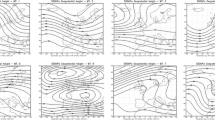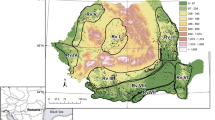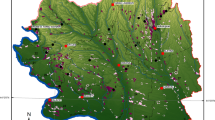Abstract
The Heliothermal Index (HI) is one of the most common methods used to identify suitable areas for viticulture, using sums of air temperatures and latitude of locations. For this study, the HI and a modified version of it was applied to estimate annual wine characteristics in the federal state of Baden-Württemberg in southwest Germany. For this process, measurement data of 11 climate stations from 1960 to 2010 were used. In order to develop a method, 40 years of observation were selected and split into 30 years for developing an estimation method and 10 years for validation. The HI was modified by varying the time periods with which the index was calculated. Time periods with little effect on wine characteristics were identified and excluded to improve the estimation. The must density could be estimated with a bias of about 1 °Oe absolute value, which equals 0.21 °Brix, a mean average error (MAE) of about 4 °Oe / 0.82 °Brix and a root mean square error (RMSE) of about 5 °Oe / 1.03 ° Brix. The titratable acidity could be estimated with a bias of about 0.1 g/L absolute value, a MAE of about 0.7 g/L and a RMSE of about 0.9 g/L.




Similar content being viewed by others
References
Amann R (2006) Die Säure in Zeiten des Klimawandels. Dtsch Weinbau 19:14–18
Becker N, Steinmetz V (2005) Rebenentwicklung und Traubenreife von zwölf Rebsorten unter dem Einfluss geographisch weit gestreuter Standorte. Mitt Klosterneuburg 55:227–238
Bock A, Sparks T, Estrella N, Menzel A (2011) Changes in the phenology and composition of wine from Franconia, Germany. Clim Res 50:69–81
Brázdil R, Zahradníček P, Dobrovolný P, Kotyza O, Valášek H (2008) Historical and recent viticulture as a source of climatological knowledge in the Czech Republic. Geografie-Sborník Cĕské Geografické Společnosti 113:351–371
Brochet F, Dubourdieu D (2001) Wine descriptive language supports cognitive specificity of chemical senses. Brain Lang 77:187–196
Dami I, Ferree D, Prajitna A, Scurlock D (2006) A five-year study on the effect of cluster thinning on yield and fruit composition of ‘Chambourcin’ grapevines. Hortscience 41:586–588
Duchêne E, Schneider C (2005) Grapevine and climatic changes: a glance at the situation in Alsace. Agron Sustain Dev 24:93–99
Gatti M, Bernizzoni F, Civardi S, Poni S (2012) Effects of cluster thinning and preflowering leaf removal on growth and grape composition in cv. Sangiovese. Am J Enol Vitic 63:325–332
Hoppmann D (2010) Terroir—Wetter, Klima und Boden im Weinbau. Ulmer, Stuttgart
Huglin P (1978) Nouveau Mode d’Évaluation des Possibilités Héliothermiques d’un Milieu Viticole. C R Seances Acad Agric France 64:1117–1126
Jones GV, White MA, Cooper OR, Storchmann K (2005a) Climate change and global wine quality. Clim Chang 73:319–343
Jones GV, Duchêne E, Tomasi D, Yuste J, Braslavska O, Schultz H, Martinez C, Boso S, Langellier F, Perruchot C, Guimberteau G (2005b) Changes in European winegrape phenology and relationships with climate. In: Proceedings of the Groupe d’Etude des Systèmes de Conduite de la vigne (GESCO 2005). Gesellschaft zur Förderung der Forschungsanstalt Geisenheim, pp 1–6
Kast WK, Rupp D (2009) Effects of climatic change on phenology and ripening conditions of grapevine. Mitt Klosterneuburg 59:3–7
Kok D (2011) Influences of pre- and post-veraison cluster thinning treatments on grape composition variables and monoterpene levels of Vitis vinifera L. cv. Sauvignon Blanc. J Food Agric Environ 9:22–26
Krieger M, Lohmann G, Laepple T (2011) Seasonal climate impacts on the grape harvest date in Burgundy (France). Clim Past 7:425–435
Löhnertz O, Hoppmann D, Emde K, Friedrich K, Schmanke M, Zimmer T (2004) Die Standortkartierung der hessischen Weinbaugebiete. Geologische Abhandlungen Hessen, 114, Wiesbaden
Malheiro AC, Santos JA, Fraga H, Pinto JG (2010) Climate change scenarios applied to viticultural zoning in Europe. Clim Res 43:163–177
Mariani L, Parisi S, Failla O, Cola G, Zoia G, Bonardi L (2009) A long time series of harvest dates for Grapevine. Ital J Agrometeorol 1:7–16
Mehofer M, Schmuckenschlager B, Hanak K, Regner F (2005) Auswertung von Klimadaten und Traubenreifeparametern mit dem Ziel einer Reifeprognose im Weinbau. Mitteilungen Klosterneuburg 55:76–84
Mehofer M, Hanak K, Schmuckenschlager B (2008) Influence of different methods of cluster thinning on the soundness of grapes and grape and must quality. Mitteilungen Klosterneuburg 58:49–57
Meier N, Rutishauser T, Pfister C, Wanner H, Luterbacher J (2007) Grape harvest dates as a proxy for Swiss April to August temperature reconstructions back to AD 1480. Geophys Res Lett 34:L20705
Neumann PA, Matzarakis A (2011) Viticulture in southwest Germany under climate change conditions. Clim Res 47:161–169
Orlandini S, Stefano VD, Lucchesini P, Puglisi A, Bartolini G (2009) Current trends of agroclimatic indices applied to grapevine in Tuscany. IDŐJÁRÁS. Q J Hung Meteorol Serv 113:69–78
Petgen M (2007) Reaktion der Reben auf den Klimawandel. Schweiz Z Obst-Weinbau 9:6–9
Reynolds AG (1989) Impact of pruning strategy, cluster thinning, and shoot removal on growth, yield, and fruit composition of low-vigor De Chaunac vines. Can J Plant Sci 69:269–275
Shanmuganathan S, Sallis P (2010) Determining the relationship between climate variations and wine quality: the WEBSOM approach. In: Simard S (ed) Climate change and variability. Sciyo, pp 389–408. http://sciyo.com/
Statistisches Bundesamt (2011) Landwirtschaftliche Bodennutzung - Rebflächen - Fachserie 3 Reihe 3.1.5 – 2010
Statistisches Landesamt BW (2008) Agrarland Baden-Württemberg—vielfältig und leistungsfähig. Statistik AKTUELL. http://www.statistik.baden-wuerttemberg.de/Veroeffentl/Statistik_AKTUELL/803408003.pdf
Statistisches Landesamt BW (2009) In aller Munde: Weine aus Baden und Württemberg. Statistik AKTUELL. http://www.statistik.baden-wuerttemberg.de/Veroeffentl/Statistik_AKTUELL/803409003.pdf
Stock M (ed) (2007) Perspektiven der Klimaänderung bis 2050 für den Weinbau in Deutschland (Klima 2050). PIK-Report 106
Sun Q, Sacks GL, Lerch SD, Vanden Heuvel JE (2012) Impact of shoot and cluster thinning on yield, fruit composition, and wine quality of corot noir. Am J Enol Vitic 63:49–56
Tonietto J, Carbonneau A (2004) A multicriteria climatic classification system for grape-growing regions worldwide. Agric For Meteorol 124:81–97
Urhausen S, Brienen S, Kapala A, Simmer C (2011) Must quality estimation based on climate data in the Upper Moselle region. Meteorol Z 20:479–485
Vogt E, Schruft G (2000) Weinbau 8. Auflage, Ulmer, Stuttgart
Winkler AJ, Cook JA, Kliewere WM, Lider LA (1974) General viticulture, 4th edn. University of California Press, Berkeley
Acknowledgements
We thank Dr. Hanns-Heinz Kassemeyer and Dr. Rainer Amann of the Staatliches Weinbauinstitut Freiburg for their advice regarding viticulture.
Author information
Authors and Affiliations
Corresponding author
Rights and permissions
About this article
Cite this article
Neumann, P.A., Matzarakis, A. Estimation of wine characteristics using a modified Heliothermal Index in Baden-Württemberg, SW Germany. Int J Biometeorol 58, 407–415 (2014). https://doi.org/10.1007/s00484-013-0637-z
Received:
Revised:
Accepted:
Published:
Issue Date:
DOI: https://doi.org/10.1007/s00484-013-0637-z




